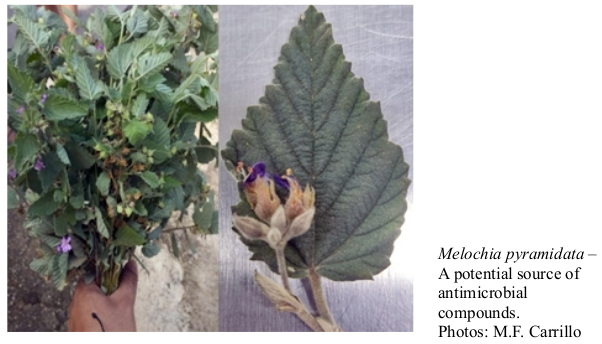Antibacterial properties of ethanolic extracts from Melochia pyramidata L.

Abstract
This study investigates the antibacterial properties of ethanolic extracts from the weed Melochia pyramidata L. Through gas chromatography-mass spectrometry (GC-MS) analysis, several compounds were identified, including pyranones, phenolic compounds, terpenes, coumarin, aryl-tetrahydrofurans, and phenylpropanoids. Among the most abundant compounds were 3,5-dihydroxy-6-methyl-2,3-dihydro-4H-pyran-4-one and palmitic acid. Although several known metabolites were identified, the main focus was on evaluating the antibacterial capacity of the complete extract. The study's findings indicate that the ethanolic extract exhibits substantial inhibition against various bacteria. Specifically, Gram-positive S. aureus showed the greatest sensitivity to the extract, with an average inhibition zone of 13.12 mm, followed by E. coli with an average inhibition of 10.95 mm. These findings suggest that the M. pyramidata extract could be a promising source for the development of antimicrobial agents. However, it is emphasized that the tests were conducted in vitro, and further research is needed to confirm the efficacy of the extract in clinical in vivo applications. This study highlights the importance of evaluating underexplored natural resources like weeds in the search for antimicrobial solutions and contributes to the understanding of the potential of M. pyramidata in antibacterial research.
Keywords
Secondary metabolites, bioactivity, Weed-derived compounds, Plant extracts, Pathogenic bacteria
References
- Alhadad, A. O., Salem, G. S., Elmhdwi, M. F., Hussein, S. M., & Elshareef, S. M. (2022). Assessments of Antibacterial and Antioxidant Properties in the Methanolic and Aqueous Leaf Extracts of Pistacia lentiscus against Different Antibiotic Resistance Pathogenic Bacteria. Advances in Bioscience and Biotechnology, 13(03), 113-133. https://doi.org/10.4236/abb.2022.133005
- Castillo-Granados, I. D. (2020). Biología reproductiva de Melochia parvifolia Kunth y Melochia spicata Fryxell Malvaceae especies simpátricas en un bosque de galería en Casanare, Orinoquia Colombiana. [Pregrado, Universidad de La Salle, Bogotá ]. https://ciencia.lasalle.edu.co/biologia/90
- Chaves-Bedoya, G., Vera, E. J., & Ortiz-Rojas, L. Y. (2022). Caracterización fitoquímica de extractos etanólicos de las hojas de Zanthoxylum Caribaeum Lam y evaluación de actividad antimicrobiana contra Burkholderia Glumae. Revista de Chimie, 73(1), 51 - 61. https://doi.org/https://doi.org/10.37358/RC.22.1.8502
- Cowan, M. M. (1999). Plant products as antimicrobial agents. Clin Microbiol Rev, 12(4), 564-582. https://doi.org/10.1128/CMR.12.4.564
- Dawood, M. A. O., El Basuini, M. F., Yilmaz, S., Abdel-Latif, H. M. R., Alagawany, M., Kari, Z. A., . . . Van Doan, H. (2022). Exploring the Roles of Dietary Herbal Essential Oils in Aquaculture: A Review. Animals, 12(7), 823. https://doi.org/10.3390/ani12070823
- Elisha, I. L., Botha, F. S., McGaw, L. J., & Eloff, J. N. (2017). The antibacterial activity of extracts of nine plant species with good activity against Escherichia coli against five other bacteria and cytotoxicity of extracts. BMC Complementary and Alternative Medicine, 17(1). https://doi.org/10.1186/s12906-017-1645-z
- Fazeli-Nasab, B., Shahraki-Mojahed, L., Sohail-Beygi, G., & Ghafari, M. (2021). Evaluation of Antimicrobial Activity of Several Medicinal Plants Against Clinically Isolated Staphylococcus aureus from Humans and Sheep. Gene, Cell and Tissue, 9(2). https://doi.org/10.5812/gct.118752
- Helmy, Y. A., Taha-Abdelaziz, K., Hawwas, H. A. E.-H., Ghosh, S., Alkafaas, S. S., Moawad, M. M. M., . . . Mawad, A. M. M. (2023). Antimicrobial Resistance and Recent Alternatives to Antibiotics for the Control of Bacterial Pathogens with an Emphasis on Foodborne Pathogens. Antibiotics, 12(2), 274. https://doi.org/10.3390/antibiotics12020274
- Hemeg, H. A., Moussa, I. M., Ibrahim, S., Dawoud, T. M., Alhaji, J. H., Mubarak, A. S., . . . Marouf, S. A. (2020). Antimicrobial effect of different herbal plant extracts against different microbial population. Saudi Journal of Biological Sciences, 27(12), 3221-3227. https://doi.org/https://doi.org/10.1016/j.sjbs.2020.08.015
- Jaramillo-Ordoñez, C. E. (2020). Actividad antifúngica y antibacteriana in vitro del extracto etanólico de Usnea laevis frente a Candida albicans, Staphylococcus aureus y Pseudomonas aeruginosa. Revista Medica Herediana, 31(3), 169-174. https://doi.org/10.20453/rmh.v31i3.3806
- Miao, Y.-H., Hu, Y.-H., Yang, J., Liu, T., Sun, J., & Wang, X.-J. (2019). Natural source, bioactivity and synthesis of benzofuran derivatives. RSC Advances, 9(47), 27510-27540. https://doi.org/10.1039/c9ra04917g
- Miethke, M., Pieroni, M., Weber, T., Brönstrup, M., Hammann, P., Halby, L., . . . Müller, R. (2021). Towards the sustainable discovery and development of new antibiotics. Nature Reviews Chemistry, 5(10), 726-749. https://doi.org/10.1038/s41570-021-00313-1
- Nikaido, H. (2009). Multidrug Resistance in Bacteria. Annual Review of Biochemistry, 78(1), 119-146. https://doi.org/10.1146/annurev.biochem.78.082907.145923
- Ortega-Buitrago, O., Chaves-Bedoya, G., & Ortiz-Rojas, L. Y. (2021). Composición química y actividad antimicrobiana del extracto etanólico de corteza y hojas de Zanthoxylum Caribaeum Cúcuta. de Norte de Santander, Colombia. Revista de Chimie, 72(4), 152-161. https://doi.org/https://doi.org/10.37358/RC.21.4.8464
- Othman, L., Sleiman, A., & Abdel-Massih, R. M. (2019). Antimicrobial Activity of Polyphenols and Alkaloids in Middle Eastern Plants. Front Microbiol, 10, 911. https://doi.org/10.3389/fmicb.2019.00911
- Piddock, L. J. (2012). The crisis of no new antibiotics--what is the way forward? Lancet Infect Dis, 12(3), 249-253. https://doi.org/10.1016/S1473-3099(11)70316-4
- Rodríguez-Cepeda, R., & Alvarez-Suarez, N. Y. (2021). Atividade antimicrobiano do extrato hidroalcoólico de Calendula Officinalis L. Revista ION, 34(1), 97-110. https://doi.org/https://doi.org/10.18273/revion.v34n1-2021008
- Rossiter, S. E., Fletcher, M. H., & Wuest, W. M. (2017). Natural Products as Platforms To Overcome Antibiotic Resistance. Chemical Reviews, 117(19), 12415-12474. https://doi.org/10.1021/acs.chemrev.7b00283
- Ruíz-Ramírez, J., García-Valle, J., Montoya-Ménez, C., Hernández-Rivera, J., Ramírez-Romero, R., & García-Márquez, L. (2018). Bovinos intoxicados por Melochia pyramidata en Colima, México. Abanico Veterinario, 8(3), 130-137. https://doi.org/10.21929/abavet2018.83.10
- Serwecińska, L. (2020). Antimicrobials and Antibiotic-Resistant Bacteria: A Risk to the Environment and to Public Health. Water, 12(12), 3313. https://doi.org/10.3390/w12123313
- Sharifi-Rad, J., Sureda, A., Tenore, G. C., Daglia, M., Sharifi-Rad, M., Valussi, M., . . . Iriti, M. (2017). Biological Activities of Essential Oils: From Plant Chemoecology to Traditional Healing Systems. Molecules, 22(1). https://doi.org/10.3390/molecules22010070
- Silhavy, T. J., Kahne, D., & Walker, S. (2010). The Bacterial Cell Envelope. Cold Spring Harbor Perspectives in Biology, 2(5), a000414-a000414. https://doi.org/10.1101/cshperspect.a000414
- Stokes, J. M., Lopatkin, A. J., Lobritz, M. A., & Collins, J. J. (2019). Bacterial Metabolism and Antibiotic Efficacy. Cell Metabolism, 30(2), 251-259. https://doi.org/10.1016/j.cmet.2019.06.009
